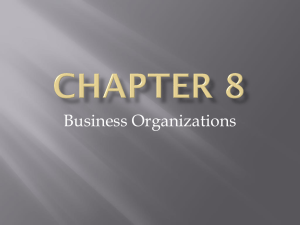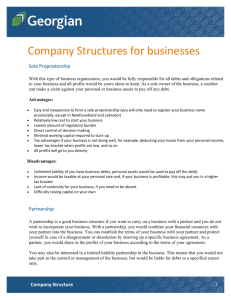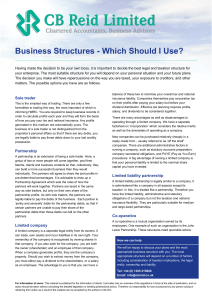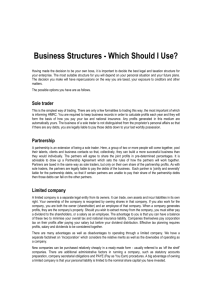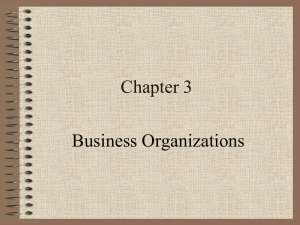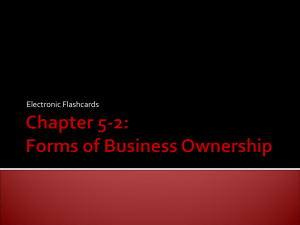Chapter 8 Notes
advertisement
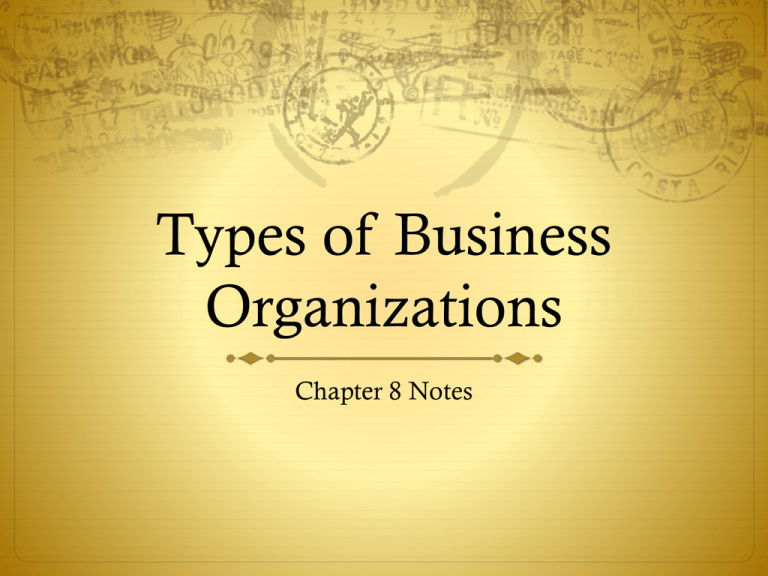
Types of Business Organizations Chapter 8 Notes Sole Proprietorships Section 1 The Characteristics of Sole Proprietorships Every business begins with an idea and someone who wants to earn money. Business organization – an enterprise that produces goods or provides services, usually to make a profit. In the course of earning profits, business provide goods and services, jobs, income, pay taxes. The most common type of business is a Sole proprietorship – a business owned and controlled by one person. About 70% of businesses in America. < 5% of sales. Read Bart’s Cosmic Comics – pg 227 Raising Funds – his own savings, loan from family and friends. Preparing to Open – business license, site permit Initial difficulties – spent money on advertising to kick start business Success – pays back loans, earns a profit, gets loan from a bank because he has proven success Sole Proprietorships: Advantages and Disadvantages Not governed by as many regulations as other types of businesses Sole proprietorship – a business owned and controlled by one person Limited life – a situation in which a business ceases to exist if the owners dies, retires of leaves Unlimited liability – a situation in which a business owner is responsible for all the losses and debts of a business ADVANTAGES Easy to Open or Close – Few Regulations – zoning, labor laws apply Freedom and Control – be your own boss Owner Keeps Profits – DISADVANTAGES Limited Funds – Limited Life – Unlimited Liability – owner is personally responsible for the debts of the business. Can lose your home, car and savings. Forms of Partnerships Section 2 Partnership – a business co-owned by two or more people, or “partners”, who agree on how responsibilities, profits, and losses should be divided Types of Partnerships 1 - General partnership – a partnership in which each partner shares the management of the business and is liable for all business debts and losses; could put personal savings at risk. Share in the rewards of the business. Found in almost all areas of business. 2 - Limited partnership – a partnership in which at least one partner is not involved in running the business and is liable only for the funds he or she invested. Consist of a General Partner and any number of limited partners. 3 - Limited liability partnership – LLP - a partnership in which all partners are not responsible for the debts and other liabilities of the other partners. Personal savings are not at risk unless the debts arise from their own mistakes. Not all businesses can register as an LLP. Those that can include medical partnerships, law firms, accounting firms; businesses in which malpractice can be an issue. ADVANTAGES Easy to Open and Close – can close the business as long as the bills are settled. Few Regulations – Partners enter into a legal agreement spelling out their rights and responsibilities as partners. Uniform Partnership Act (UPA) Access to Resources – more funds; easier to get loans and keep workers. Joint Decision Making – each partner bring his or her perspective to the decision making process. The exception is limited partnership; limited partners do not get to participate in running the business. Specialization – each partner may bring specific skills to the business. DISADVANTAGES Unlimited liability – a situation in which a business owner is responsible for all the losses and debts of a business; personal savings and property are at risk to settle the businesses debts. Potential for Conflict – multiple decision makers Limited life – a situation in which a business ceases to exist if the owners dies, retires of leaves; new partnership agreements must be established if a partner leaves or a new partner is added. The business as it was originally formed ceases to exist. Corporations, Mergers and Multinationals Section 3 Characteristics of a Corporation Corporation – a business owned by shareholders, also called stockholders, who own the rights to the company’s profits but face only limited liability for the company’s debts and losses Shareholders acquire ownership rights through the purchase of Stock – shares of ownership in a corporation If a company does well it can pay a Dividend – the part of a corporations profit that the company pays the stockholders Public company – a corporation that issues stock that can be freely traded Private company – a corporation that controls who can buy or sell its stock Corporations make up about 20% of the number of businesses in the US, but they produce most of the goods and services and employ the majority of workers. Stock Holders elect a Board of Directors that hires Corporate Officers that are in charge of the running of the company. The stockholders and board of directors are not involved in the day-to-day operation of the company. Corporations: Advantages and Disadvantages ADVANTAGES Access to Resources – borrow from banks, sell stocks, issue Bonds – a contract a corporation issues that promises to repay borrowed money, plus interest, on a fixed schedule. All these resources allow corporations to expand their business. Just don’t have to rely on company profits. Professional Managers – corporations can hire people with strong backgrounds in management to run different divisions of the company. Limit Liability - Limited liability – a situation in which a business owner’s liability for business debts and losses is limited. Stockholders are liable only for the money they paid for their stock. The board of directors and officers are protected from liability. Unlimited life – a situation in which a corporation continues to exist even after a change in ownership. DISADVANTAGES Start-up cost and effort – setting up a corporation is more difficult , time-consuming and expensive than setting up a partnership or sole proprietorship. Paperwork has to be filed with the state; lawyers. Heavy Regulation – annual reports for the Securities and Exchange Commission (SEC); quarterly financial reports for stockholders; annual meetings for stockholders. Double Taxation – Taxes are paid on corporate earnings and then again on dividends paid out to shareholders. Loss of Control – founders of a company may lose control of the company when they bring in other members of the board of directors. Business Consolidation Why do businesses consolidate? Increased efficiency Gaining a new identity as a business or losing an old one Keeping rivals out of a market place Diversifying the product line Horizontal merger – the joining of two or more companies that offer the same or similar products or services Vertical merger – the combining of two or more businesses involved in different steps of producing or marketing a product or service Mergers make both companies more efficient by taking advantage of each others strengths - types of mergers Conglomerate – a business composed of companies that produce unrelated goods or services; diversification; the parent company is protected against isolated economic pressures Multinational corporation – a corporation with branches in several countries; provide new jobs, services and goods around the world and spread technological advances. Jobs and tax revenues help raise the standard of living in poorer countries. However, some nations have lax environmental and labor regulations. Franchises, Co-ops, and Nonprofits Section 4 Franchises Franchise – a business made up of semi-independent businesses that all offer the same products or services Franchisee – a semi-independent that pays a fee for the rights to sell the parent company’s products or services in a particular area Franchises – ADVANTAGES Higher level of independence than working for someone else. Franchiser provides good training in running the business. Franchiser provides proven products, common décor at a relatively low cost. Franchiser provides national or regional advertising to bring in customers. Franchises – DISADVANTAGES Franchisee Invest money with no guarantee of success. Franchisee has to share some of the profits with the franchiser. Franchisee does not have control over some aspects of the business; has to buy materials only from the franchiser and is limited in selling only products offered by the franchiser. CORPORATION FRANCHISEES 1 – McDonald’s 30,300 2 – Yum! Brands (KFC< Taco Bell, etc) 29,300 3 – 7-Eleven 28,200 4 – Cendent (Howard Johnson’s, Avis, etc.) 24,600 5 - Subway 21,000 Cooperatives and Nonprofits Most businesses exist to earn a profit. Not all businesses exist to make a profit. Cooperative – a type of business that operates for the shared benefit of the owners, who are also its customers Nonprofit organization – an institution that acts like a business but exist to benefit society rather than to make a profit A Business Organization for its Members When people who need a good or service band together and act like a business they can offer low prices by reducing or eliminating profits. The are called co-ops. Three basic types of co-ops: CONSUMER – purchasing co-ops. Consumer co-ops require some kind of membership payment, either in the form of labor or monetary fees. They keep prices low by purchasing goods in large volumes at a discount price. (Organic food co-op, warehouse club) SERVICE – Offer their members a service. (Credit Unions) PRODUCER – Mainly owned and operated by producers of Agriculture products. Join together to ensure cheaper, more efficient processing or better marketing of their products. A Purpose other than Profit - Nonprofits Some benefit society – American Red Cross – provide services at little or no cost. Professional organizations – promote the common interest of their members – American Bar Association Business associations, trade associations, labor unions, museums – all types of organizations perusing goals other than profit. Structure resembles a corporation but don’t pay taxes because they don’t make money, yet serve society. Raise money through donations, grants, membership fees. Sell goods or services not to make profits but as a way to raise funds.

